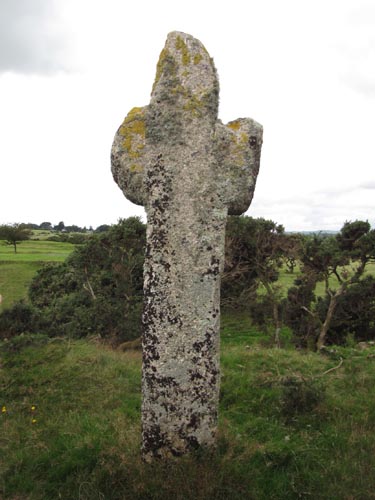 Location:
In the centre of the
Tavistock Golf Course. The cross can be found on the skyline, to the north
of the Tavistock to Sampford Spiney road, which runs across the golf
course, and beside the road which leads up to Moorshop. Location:
In the centre of the
Tavistock Golf Course. The cross can be found on the skyline, to the north
of the Tavistock to Sampford Spiney road, which runs across the golf
course, and beside the road which leads up to Moorshop.O/S Grid Ref: SX/50126/ 73671 Longitude/Latitude (Degrees+/-): -4.11658/50.54354 Map location: Click here to view map. Purpose: The cross was erected as a waymarker for the track across Whitchurch Down, leading into Tavistock. This track would have been regularly used by the monks on their journeys to the Tavistock Abbey from both the Buckfast Abbey, via the Monks’ Path, and the Plympton Priory. Size: 7 feet 4 inches (2.24 metres) tall. 2 feet 5 inches (0.74 metres) across the arms. The shaft is 14 inches (0.36 metres) wide and 12˝ inches (0.32 metres) deep. Information: The cross sits on the western edge of a raised bank, amid the gorse bushes, which surrounds a large hollow. The hollow, which was originally formed as a small quarry, now contains a hut, which I presume is owned and used by the golf club. The circumference of the raised bank extends to about 150 metres.
In researching the cross, I have come across two legends attached to it, neither of which can be substantiated. The first says that wayward prisoners, from Princetown, were once taken to the cross to be whipped in punishment. The second, however, surrounds a newly appointed vicar to the parish of Walkhampton, during the dissolution of the monasteries in the 16th century. In order to follow the Puritan ethic, he set out to rid his parish of all religious idols, such as crucifixes, statues of saints and wayside crosses. When he found out about the Pixies Cross, he gave instructions to his parishioners that it was to be destroyed. Unable to find any volunteers to undertake this task, he picked up his tools and decided to do the job himself. He had not been working long, when he became aware of a snorting presence behind him. Carefully glancing around, he found himself face to face with a large and vicious-looking black bull. Quickly weighing up the options he decided that it would be futile to try and run away and did the next best thing by shinning up the cross. There he sat, astride the cross with his legs over the arms and with the bull looking up at him. The bull was a very determined creature and kept up a constant vigil throughout the whole of the day and the night that followed. There was no way in which he was going to let this outsider destroy the cross. Early the next morning, a little old lady was crossing the common on her way to sell her wares at the Tavistock Market. In the morning gloom and from a distance, the figure cloaked in black, sitting astride the cross and with a large horned animal at its feet, gave the appearance of a visit by the devil with his horned goat. She gave the scene a wide berth and managed to reach the safety of Whitchurch village, where she reported her sighting to a group of local men. Being of an inquisitive nature, several of these men decided to walk up to the common to investigate this sighting. On arriving at the cross, they realised not only that it was their vicar that the old lady saw, but also the reason for him being there in the first place. The men were able to drive the bull away and rescue their vicar, but not before they had extracted a promise from him that the cross would be allowed to remain unharmed. On a fine day, this cross provides an excellent viewpoint for a number of prominent moorland features. The principal ones, shown in clockwise order, being: Brentor Church, Great Links Tor, Cox Tor, Great & Middle Staple Tors, Hollow Tor, North Hessary Mast and King’s Tor. |